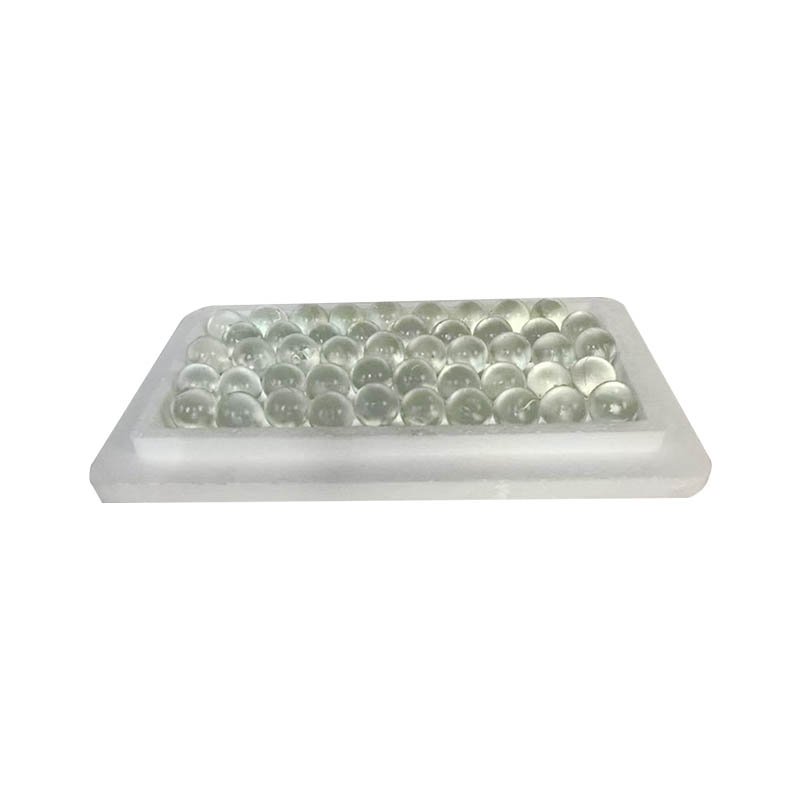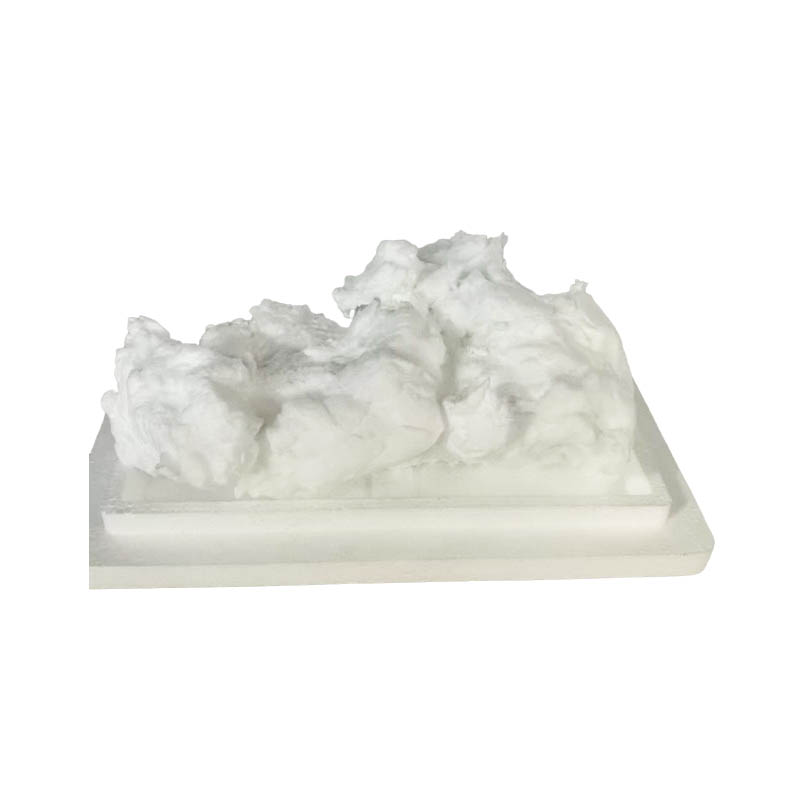How does the length and diameter distribution of glass microfibers affect filter paper strength?
Release Time : 2025-10-17
In the field of high-efficiency air filtration, glass microfiber serves as a core substrate and is widely used in the manufacture of high-performance filter papers such as HEPA and ULPA. Its excellent high-temperature and corrosion resistance, low resistance, and high efficiency make it a key material for ventilation systems in cleanrooms, medical equipment, aerospace, and new energy vehicle battery packs. However, filter paper must not only have high filtration efficiency but also possess sufficient mechanical strength to withstand the winding tension during production, the tensile stress during installation, and the airflow impact during long-term operation. The strength of filter paper is largely determined by the physical properties of its raw material, the glass microfiber, particularly its fiber length and diameter distribution. These two factors directly determine the tensile strength, tear strength, and structural stability of the final filter paper by affecting the contact area between fibers, the degree of entanglement, and the efficiency of stress transfer.
1. Fiber Length: Determines Entanglement Capacity and Network Strength
Fiber length is a key factor influencing filter paper strength. Longer glass microfibers are more likely to intertwine and entangle during the web formation process, forming a three-dimensional network structure. This entanglement effect, similar to a "microscopic steel mesh," effectively disperses external forces, enhancing the filter paper's overall tensile strength and tear resistance. When external forces act on the filter paper, the stress is transferred over a larger area through the long fibers, preventing localized stress concentration and breakage. Conversely, if the fibers are too short, there are fewer contact points, resulting in weak entanglement and a loose fiber network. This can easily cause slippage or detachment under stress, weakening the filter paper's strength and causing damage. However, longer fibers are not necessarily better. Excessively long fibers are difficult to disperse evenly during the centrifugal fiberization process, easily forming "fiber bundles" or "lumps," resulting in uneven thickness in the filter paper and weakening its overall performance. Therefore, ideal glass microfibers require a balance between length and dispersibility, typically ranging from a few millimeters to more than ten millimeters. This ensures good entanglement strength while facilitating uniform distribution during wet-laid web formation.
2. Fiber Diameter: Influencing Specific Surface Area and Contact Density
Fiber diameter directly affects the specific surface area per unit mass and the number of fibers per unit volume. Glass microfibers typically have diameters between 0.5 and 3 microns, making them ultrafine fibers. A smaller diameter increases the specific surface area, leading to stronger van der Waals forces and physical adsorption between fibers, which helps strengthen the cohesion of the fiber network. Furthermore, fine fibers contain more fibers within a given volume, significantly increasing the number of contact points and friction points between them, creating a denser interwoven structure and improving the filter paper's tensile strength and puncture resistance. However, excessively fine fibers can also be brittle and prone to breakage. Furthermore, they require more precise dispersion techniques during web formation and are prone to agglomeration due to static electricity or surface tension. Furthermore, while excessively fine fibers enhance strength, they can also increase airflow resistance, compromising filtration efficiency. Therefore, uniform diameter distribution is crucial. Ideally, glass microfibers should have a narrow diameter range to avoid a mix of coarse and fine fibers, which can lead to uneven stress transfer and create weak links.
3. Synergistic Effect of Length and Diameter: Building a Stable Three-Dimensional Network
The strength of filter paper is not determined by a single parameter but rather by the combined effects of fiber length and diameter. Long, thin fibers are most conducive to forming a strong network: long fibers provide excellent structural support and stress transfer pathways, while thin fibers fill voids, increase contact points, and enhance network density. This combination ensures sufficient mechanical strength for filter paper at a low weight while maintaining good air permeability. Furthermore, the fiber length-to-diameter ratio is a key parameter. Fibers with a high aspect ratio are more easily oriented in suspension, resulting in a more ordered and stable structure after web formation, which improves the isotropic strength of the filter paper. Centrifugal processing can effectively control the fiber aspect ratio by adjusting melt viscosity, rotational speed, and airflow cooling rate, thereby optimizing the mechanical properties of the final product.
4. Process Control and Post-Processing Enhancement
While the raw fiber properties are crucial, subsequent papermaking processes also have a significant impact on strength. During wet web formation, fiber alignment and interweaving density can be optimized by adjusting slurry concentration, flow rate, and dewatering speed. In addition, some high-performance filter papers utilize micro-melt bonding or a small amount of environmentally friendly adhesive for reinforcement. This allows for localized fusion of fibers at intersections, further enhancing overall structural strength without excessively sacrificing air permeability.
In summary, the length and diameter distribution of glass microfibers are key factors in determining the mechanical strength of filter paper. Longer fibers enhance entanglement and stress transfer, while finer fibers increase contact density and network compactness. These two factors work synergistically to create a strong and efficient three-dimensional filter structure. Precisely controlling centrifugation process parameters to obtain glass microfibers of appropriate length, uniform diameter, and optimized aspect ratio is the key to producing high-strength, long-life air filter paper.
1. Fiber Length: Determines Entanglement Capacity and Network Strength
Fiber length is a key factor influencing filter paper strength. Longer glass microfibers are more likely to intertwine and entangle during the web formation process, forming a three-dimensional network structure. This entanglement effect, similar to a "microscopic steel mesh," effectively disperses external forces, enhancing the filter paper's overall tensile strength and tear resistance. When external forces act on the filter paper, the stress is transferred over a larger area through the long fibers, preventing localized stress concentration and breakage. Conversely, if the fibers are too short, there are fewer contact points, resulting in weak entanglement and a loose fiber network. This can easily cause slippage or detachment under stress, weakening the filter paper's strength and causing damage. However, longer fibers are not necessarily better. Excessively long fibers are difficult to disperse evenly during the centrifugal fiberization process, easily forming "fiber bundles" or "lumps," resulting in uneven thickness in the filter paper and weakening its overall performance. Therefore, ideal glass microfibers require a balance between length and dispersibility, typically ranging from a few millimeters to more than ten millimeters. This ensures good entanglement strength while facilitating uniform distribution during wet-laid web formation.
2. Fiber Diameter: Influencing Specific Surface Area and Contact Density
Fiber diameter directly affects the specific surface area per unit mass and the number of fibers per unit volume. Glass microfibers typically have diameters between 0.5 and 3 microns, making them ultrafine fibers. A smaller diameter increases the specific surface area, leading to stronger van der Waals forces and physical adsorption between fibers, which helps strengthen the cohesion of the fiber network. Furthermore, fine fibers contain more fibers within a given volume, significantly increasing the number of contact points and friction points between them, creating a denser interwoven structure and improving the filter paper's tensile strength and puncture resistance. However, excessively fine fibers can also be brittle and prone to breakage. Furthermore, they require more precise dispersion techniques during web formation and are prone to agglomeration due to static electricity or surface tension. Furthermore, while excessively fine fibers enhance strength, they can also increase airflow resistance, compromising filtration efficiency. Therefore, uniform diameter distribution is crucial. Ideally, glass microfibers should have a narrow diameter range to avoid a mix of coarse and fine fibers, which can lead to uneven stress transfer and create weak links.
3. Synergistic Effect of Length and Diameter: Building a Stable Three-Dimensional Network
The strength of filter paper is not determined by a single parameter but rather by the combined effects of fiber length and diameter. Long, thin fibers are most conducive to forming a strong network: long fibers provide excellent structural support and stress transfer pathways, while thin fibers fill voids, increase contact points, and enhance network density. This combination ensures sufficient mechanical strength for filter paper at a low weight while maintaining good air permeability. Furthermore, the fiber length-to-diameter ratio is a key parameter. Fibers with a high aspect ratio are more easily oriented in suspension, resulting in a more ordered and stable structure after web formation, which improves the isotropic strength of the filter paper. Centrifugal processing can effectively control the fiber aspect ratio by adjusting melt viscosity, rotational speed, and airflow cooling rate, thereby optimizing the mechanical properties of the final product.
4. Process Control and Post-Processing Enhancement
While the raw fiber properties are crucial, subsequent papermaking processes also have a significant impact on strength. During wet web formation, fiber alignment and interweaving density can be optimized by adjusting slurry concentration, flow rate, and dewatering speed. In addition, some high-performance filter papers utilize micro-melt bonding or a small amount of environmentally friendly adhesive for reinforcement. This allows for localized fusion of fibers at intersections, further enhancing overall structural strength without excessively sacrificing air permeability.
In summary, the length and diameter distribution of glass microfibers are key factors in determining the mechanical strength of filter paper. Longer fibers enhance entanglement and stress transfer, while finer fibers increase contact density and network compactness. These two factors work synergistically to create a strong and efficient three-dimensional filter structure. Precisely controlling centrifugation process parameters to obtain glass microfibers of appropriate length, uniform diameter, and optimized aspect ratio is the key to producing high-strength, long-life air filter paper.






